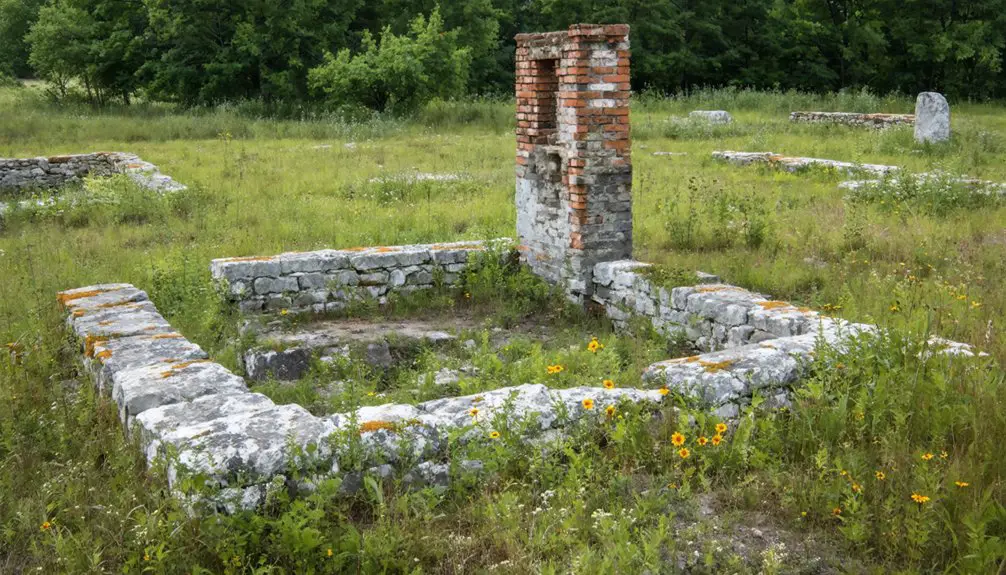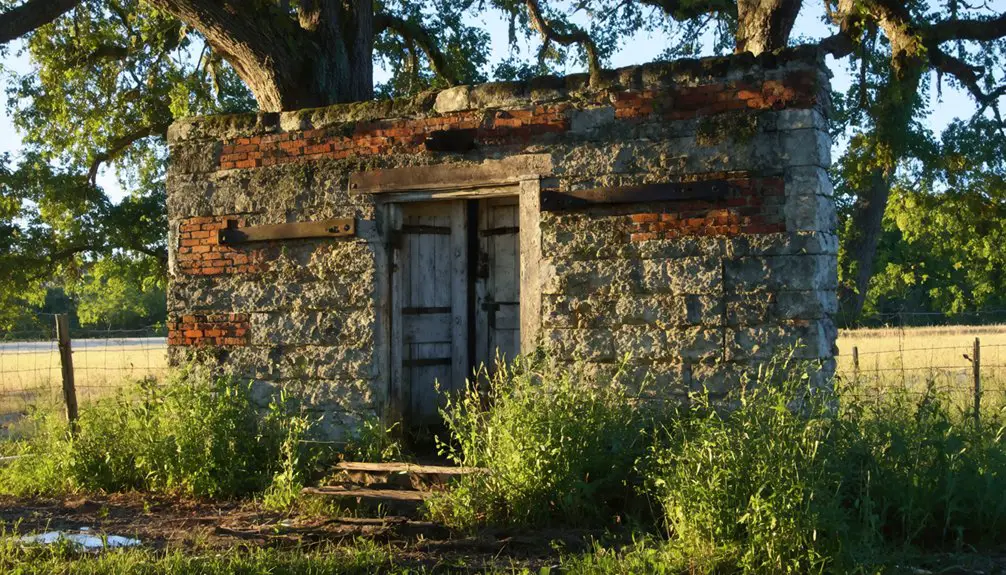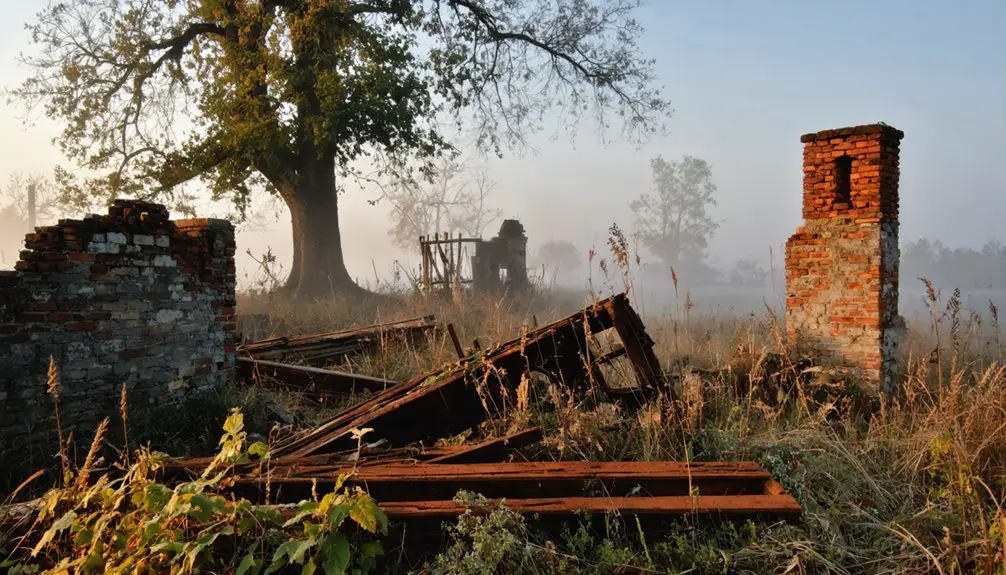You’ll discover the remains of Doaksville, Oklahoma’s most historically significant ghost town, which flourished as the Choctaw Nation’s capital from 1850 to 1863. Once a bustling frontier trading post with five major stores and 30 buildings, it served as an essential political center until the Civil War. The town’s decline began with Fort Towson’s abandonment in 1854, culminating in its desertion by 1870. The archaeological site’s rich artifacts and ghostly tales hold secrets waiting to be uncovered.
Key Takeaways
- Doaksville was once a thriving Choctaw Nation commercial center near the Kiamichi River, but declined into a ghost town by 1870.
- Archaeological excavations revealed remains of over 30 buildings, including a jail, hotel, and hospital from the settlement’s peak period.
- The town’s decline began with Fort Towson’s abandonment in 1854 and accelerated during the Civil War’s economic disruption.
- Doaksville Cemetery features supernatural legends, including the “LeFlore Ghost” story of a young woman and her stillborn child.
- The ghost town site is now protected as an archaeological preserve under the National Register of Historic Places.
The Birth of a Frontier Trading Hub
While the American frontier was rapidly expanding westward in the 1820s, Josiah S. Doaks and his brother strategically established a trading post near the Kiamichi River’s mouth. They’d anticipated the arrival of Choctaw Indians following the Treaty of Doak’s Stand, positioning themselves at the crossroads of emerging trading dynamics.
You’ll find their settlement’s origins deeply intertwined with Fort Towson‘s 1824 establishment, as the post relocated nearby for enhanced protection against Plains Indian raids. The location proved ideal for cultural exchange, drawing settlers who joined the Doaks for mutual security. By 1840, the town had grown into a significant commercial center with five major stores serving the community.
Capitalizing on Red River steamboat accessibility, traders moved goods efficiently from the Mississippi. The development of the Central National Road enabled increased trade opportunities and regional connections. This convergence of military presence, river transport, and frontier commerce transformed a simple trading post into a bustling settlement at the heart of Indian Territory.
Choctaw Nation’s Capital: Power and Politics
From its emergence as a trading post, Doaksville evolved into the political epicenter of the Choctaw Nation, serving as its capital from 1850 to 1863.
You’ll find that during this period, the town wielded considerable influence, hosting essential political conventions and serving as an important hub for tribal governance. The 1860 Doaksville Constitution, ratified here, shaped Choctaw politics until 1906.
Doaksville emerged as a vital center of Choctaw political life, where key decisions and constitutional changes shaped tribal destiny.
The town’s political legacy extended beyond its role as capital. Two significant publications, the Choctaw Telegraph and Intelligencer, helped spread news and information throughout the territory. The town supported five large stores that served as economic and social gathering points.
You’d have witnessed thousands gathering for tribal annuity distributions, making Doaksville a center of both administrative functions and social cohesion.
Even after the Civil War, when Confederate General Stand Watie’s surrender marked a significant moment in 1865, the town’s significance in shaping Indian Territory politics remained, though its power gradually diminished following the capital’s relocation.
Commerce and Daily Life Along the Red River
As Doaksville flourished along the Red River, its strategic location at the intersection of major trade routes transformed it into a bustling commercial hub.
You’d find diverse trade dynamics at work, with five major merchandise stores operating by 1840, owned by both Choctaw Indians and licensed white traders. A 30-building settlement emerged during the town’s peak period in the 1840s and 1850s.
The town’s economic significance centered on three key elements:
- Steamboat traffic connecting to New Orleans
- Multiple established roads linking to Fort Smith and Fort Jessup
- A thriving agricultural export business
Daily social interactions reflected a remarkably integrated frontier community where Choctaws, Chickasaws, Delawares, and others gathered for commerce and cultural exchange. The town’s position at the junction of military roads made it a natural meeting point for travelers and traders.
During annuity days, thousands would converge at the trading house, creating a vibrant marketplace where you’d witness buying, selling, and socializing across ethnic boundaries.
Fort Towson’s Influence on Settlement Growth
When Fort Towson established its military presence in 1824 near the Kiamichi and Red River confluence, it catalyzed significant settlement growth throughout the region.
The fort’s military influence directly shaped settlement patterns by attracting traders, settlers, and Choctaw officials who sought protection and economic opportunities in the area. During its active years, the fort served as a critical paymaster headquarters under Nathaniel Towson’s command. With a typical garrison of 75 to 100 troops, the fort maintained a strong military presence in the territory.
The fort’s strategic role went beyond mere defense – it served as a dispersal point for relocated Choctaw Indians while simultaneously protecting them from illegal settler encroachment.
The military’s road-building efforts connected Fort Towson to other outposts, creating crucial trade routes that encouraged civilian enterprises to flourish.
As communities like Doaksville grew around the fort, you’d see how its presence fostered a stable environment where both native and settler populations could establish lasting settlements.
Civil War Impact and Confederate Surrender
You’ll find Doaksville’s Civil War story marked by Confederate General Stand Watie’s historic last surrender of the conflict on June 23, 1865, when he capitulated to Union forces near Fort Towson with his mixed contingent of Creek, Seminole, Cherokee, and Osage troops.
The town had served as the Choctaw Nation capital from 1860 to 1863 before relocating to Chahta Tamaha.
Today, visitors can explore the 3/4-mile interpretive trail that winds through the remnants of this once-bustling town.
The war’s devastation hit Doaksville hard, destroying personal property and disrupting its plantation economy through severe labor shortages and agricultural decline.
The town’s postwar collapse accelerated when a new railroad bypassed it in 1870, shifting regional commerce away from what would eventually become a ghost town.
Confederate Military Operations
During the Civil War, Doaksville emerged as a critical Confederate stronghold due to its proximity to Fort Towson, where Brigadier General Stand Watie commanded a diverse force of Cherokee, Creek, Seminole, and Osage Indians.
Confederate strategies in the region focused on partisan ranger-style operations rather than conventional warfare, as maintaining control of fixed positions proved challenging against advancing Union forces.
The Confederacy’s military logistics in Indian Territory faced significant challenges:
- Supply lines were frequently disrupted after Union victories at key battles like Pea Ridge.
- Confederate forces struggled to hold and defend established forts.
- Watie’s troops were forced to operate independently due to isolation from main Confederate armies.
This operational reality led to a gradual weakening of Confederate control in the region, though Watie’s forces continued resistance until their historic surrender in June 1865.
Stand Watie’s Final Stand
At the heart of Doaksville’s Civil War legacy stands the historic surrender of Brigadier General Stand Watie, the last Confederate general to lay down arms on June 23, 1865.
As the only American Indian to achieve brigadier general rank in Confederate forces, Watie’s leadership proved essential in commanding the First Indian Brigade, comprising Cherokee, Seminole, Creek, Choctaw, and Chickasaw troops.
Your understanding of Doaksville’s significance deepens when you consider how Watie’s surrender to Lt. Col. Asa C. Matthews reflected the Cherokee division between Union and Confederate loyalties.
The formal cease-fire agreement, documented in a three-page handwritten treaty, marked the end of organized Confederate resistance in Indian Territory.
This pivotal moment enabled the Five Civilized Tribes to begin their challenging journey toward post-war reconstruction and reintegration.
Post-War Economic Devastation
While Stand Watie’s surrender marked the end of Confederate resistance in Indian Territory, Doaksville’s economic decline had already begun years earlier with Fort Towson’s abandonment in 1854.
The Civil War accelerated this downward spiral, triggering a devastating plantation collapse and widespread economic turmoil throughout the region.
You’ll find three critical factors that sealed Doaksville’s fate:
- The elimination of slave-based plantation economics destroyed the town’s wealth foundation
- Extensive property destruction and infrastructure damage crippled recovery efforts
- The relocation of the Choctaw capital to Armstrong Academy in 1863 stripped Doaksville of its political importance
The combined impact of military withdrawal, wartime devastation, and political repositioning transformed this once-thriving commercial hub into an increasingly abandoned settlement by 1870.
Archaeological Discoveries and Preserved Ruins

Extensive archaeological excavations conducted between 1995 and 1997 by the Oklahoma Historical Society revealed Doaksville’s rich material heritage through limestone foundations, artifacts, and structural remains.
The archaeological findings uncovered evidence of over thirty buildings, including a jail, hotel, and hospital, while thousands of artifacts like ceramic shards, nails, and animal bones paint a picture of daily life in the settlement.
Today, you’ll find preserved structures scattered across the landscape, including stone wells and a distinctive three-cell jail outline.
A walkway installed in 2001 guides you through the site’s key features, with interpretive panels explaining the ruins along a 3/4-mile trail.
Though vandalism and natural erosion have taken their toll, the site remains protected as an archaeological preserve under the National Register of Historic Places.
Tales From the Ghost Town
Beyond the physical remnants of Doaksville’s ruins lies a rich tapestry of ghostly tales and historical mysteries that have captivated visitors for generations.
You’ll find the most compelling haunted legends centered around Doaksville Cemetery, where former residents are said to still roam. The most notable ghostly sightings involve the “LeFlore Ghost,” a tragic tale of a young woman who died mysteriously at Dr. Folsom’s house.
The town’s supernatural heritage includes:
- A young woman’s spirit, possibly from Arkansas, buried with her stillborn child
- Unexplained phenomena tied to former residents of the abandoned town
- Paranormal activities that blend with Choctaw tribal history
These stories aren’t mere entertainment – they’re woven into the fabric of Doaksville’s cultural legacy, reflecting the complex history of this once-thriving community.
The Great Migration: Why Residents Left

You’ll find that Doaksville’s decline accelerated when major railway lines bypassed the once-thriving town in favor of other regional routes.
The absence of rail connections severely limited residents’ access to broader markets and economic opportunities, pushing many to relocate to better-connected communities.
As businesses shuttered and jobs became scarce, families were forced to abandon their homes in search of more sustainable livelihoods elsewhere.
Railroad Bypasses Town’s Growth
When the San Francisco and St. Louis Railway made its significant route decision in 1900-1901, they bypassed Doaksville completely, building tracks a few miles south near Fort Towson.
This railroad influence proved devastating for Doaksville’s survival, leading to a swift town relocation as residents and businesses moved closer to the essential transportation link.
The railroad’s impact triggered three major changes:
- Mass exodus of residents who physically moved their homes and businesses to Fort Towson
- Closure and renaming of Doaksville’s post office to Fort Towson in 1903
- Abandonment of remaining structures as the town emptied
You can trace this pattern throughout Indian Territory, where railroad placement determined which communities thrived and which disappeared.
For Doaksville, already weakened by Civil War damage, the railroad bypass sealed its fate.
Economic Opportunities Fade Away
The devastating combination of agricultural hardships and systemic discrimination created an economic death spiral for Doaksville’s residents in the early 20th century.
You’d have witnessed the town’s economic decline through multiple crises: the boll weevil’s destruction of cotton crops, persistent flooding, and the sharecropping system that trapped both African Americans and poor whites in cycles of debt.
Without industrial alternatives, agricultural challenges left families with few options for survival.
As Jim Crow laws restricted opportunities and racial violence intensified, many residents joined the Great Migration northward.
They sought better wages in steel mills, automobile plants, and meatpacking facilities.
Through established networks, you could find support for relocation, often including free transportation and housing – making the decision to leave Doaksville’s deteriorating economy more feasible.
Cultural Heritage and Sacred Grounds
As a principal town of the Choctaw Nation following their forced relocation from the Southeast, Doaksville emerged as an essential center of cultural heritage and spiritual significance.
The town’s cultural significance is preserved through its archaeological remains and sacred grounds, particularly the Doaksville Cemetery, which stands as a symbol of community memory and resilience.
You’ll find three key elements that defined Doaksville’s spiritual landscape:
- The cemetery preserves graves of prominent residents and serves as a sacred communal space
- Newspapers like the Choctaw Telegraph fostered cultural communication and political discourse
- The 1860 Doaksville Constitution represented the Nation’s commitment to self-governance
Today, the protected site, managed by the Oklahoma Historical Society, continues to connect visitors with the enduring spirit of Choctaw heritage through interpretive trails and preserved burial grounds.
Railroad’s Bypass: The Final Chapter
Following the demise of Fort Towson‘s military presence in 1854, Doaksville faced its most decisive blow in 1900-1901 when the St. Louis and San Francisco Railroad bypassed the town by several miles to the south.
The railroad effects were swift and devastating, as the new tracks favored Fort Towson’s development instead.
You’ll find that economic shifts occurred rapidly as businesses and residents recognized the critical importance of rail access. Rather than face isolation, many chose to physically relocate their homes and enterprises to Fort Towson.
Frequently Asked Questions
What Happened to Josiah Stuart Doak After the Town’s Decline?
Like mist fading into history, you can’t trace Josiah Doak’s fate after Doaksville’s decline. His legacy vanished with the town’s demise, leaving no documented records of his later life.
Were There Any Documented Epidemics or Natural Disasters in Doaksville?
You won’t find any verified epidemic outbreaks or natural disasters in historical records. Archaeological evidence and primary sources show the town’s decline came from economic factors and infrastructure changes instead.
How Many People Lived in Doaksville During Its Peak Population?
Like a star that burns brightest before fading, you’d find the town’s population growth peaked with several hundred residents in the 1850s, though exact town demographics weren’t officially documented.
What Traditional Choctaw Ceremonies Were Regularly Performed in Doaksville?
You’ll find traditional rituals like annuity payment gatherings, marriage ceremonies under Choctaw law, and stomp dances were practiced regularly. While Green Corn ceremonies held cultural significance, specific details remain limited.
Did Any Famous Outlaws or Lawmen Operate in Doaksville?
While outlaw legends and lawman tales circulate around Indian Territory, you’ll find no direct evidence of famous outlaws or lawmen operating specifically in Doaksville, though deputies patrolled the broader region.
References
- https://en.wikipedia.org/wiki/Doaksville
- https://choctawspirit.wordpress.com/2019/02/18/the-leflore-ghost-and-other-tales-of-doaksville/
- https://www.redriverhistorian.com/post/doaksville-choctaw-county-oklahoma
- https://www.okhistory.org/publications/enc/entry?entry=DO002
- https://www.legendsofamerica.com/ok-doaksville/
- https://mike-boucher.com/wordpress/?page_id=244
- http://blogoklahoma.us/place/123/choctaw/doaksville
- https://carynschulenberg.com/2024/09/make-or-break/
- https://www.okhistory.org/sites/doaksville
- https://www.hmdb.org/m.asp?m=237791



